1820-1829
Durrie
Connecticut
United States
The World
Paintings
Durrie
1820
George Henry Durrie is born in New Haven, CT on June 6th. He is baptized on October 22, 1820 in New Haven, CT.
The World
1821
Napoleon, the famous French political and military leader, dies on May 5th, in St. Helena.
United States
1825
Thomas Cole founds the Hudson River School, starting a movement of influential landscape artists.
United States
1826
Both former presidents Thomas Jefferson and John Adams die on Independence Day.
Connecticut
1828
Farmington Canal opened.
1830-1839
Durrie
Connecticut
United States
The World
Paintings
United States
1831
The staunch abolitionist William Lloyd Garrison begins publishing his antislavery paper, The Liberator, that would become a critical part of the abolitionist movement.
Paintings
1831
Thomas Cole paints Study for a Wild Scene, now in the Florence Griswold Museum
Connecticut
1832
Yale University Art Gallery, the oldest college art museum in the country, is founded after a generous donation from John Trumbull.
The World
1833
Slavery is abolished in the British Empire.
Connecticut
1836
Samuel Colt, Hartford resident, receives U.S. patent for the revolver.
Connecticut
1838
Railroad completed between New Haven and Hartford.
Durrie
1839
George Durrie and his older brother John (1818-1890) begin taking art lessons from Nathaniel Jocelyn (1796-1881), a New Haven engraver and portraitist.
Durrie begins to paint portraits in the Bethany and Hartford areas.
Connecticut
1839
Africans from the Amistad held on trial and imprisoned in New Haven.
The World
1839
The Daguerreotype, the first photographing process available to the public, is introduced worldwide. Though only popular for the next two decades, it played an influential role in the advancement of photography, and allowed major historical figures, such as Andrew Jackson and Abraham Lincoln, to be captured in picture.
1840-1849
Durrie
Connecticut
United States
The World
Paintings
Durrie
1840
Durrie paints family portraits in Naugatuck and Meriden, CT.
Connecticut
1840
Connecticut begins to hit its peak of whaling in ports around the state.
Durrie
1841
Durrie marries Sarah A. Perkins (1814-1900) of Bethany, CT, on September 14th, and they settle in New Haven.
Durrie and Sarah’s first son, George Boice Durrie, is born on October 9th.
United States
1841
William Henry Harrison becomes the first president to die in office, and is succeeded by Vice President John Tyler.
Connecticut
1842
Wadsworth Atheneum, the first public art museum in America, opens in Hartford.
Durrie
1844
Durrie shows another snow scene, The Sleighing Party at the National Academy of Design, New York.
Connecticut
1844
Charles Goodyear, of Connecticut, receives patent for vulcanized rubber, which would spark effective rubber manufacturing in Connecticut.
United States
1844
Sam Morse sends historic first message through the first commercial telegraph line from Washington to Baltimore, rapidly changing the speed and way that Americans communicate and live.
Durrie
1845
Durrie begins to keep a daily diary recording the weather and his day to day activities (art sessions, church visits, lectures, meals, etc.) on January 1 and continues until July 1, 1846. Diary is currently in the archives of the New Haven Museum.
United States
1845
President Tyler annexes Texas, making it the 28th state to be admitted to the Union.
The World
1845
The Great Famine, also known as the Irish Potato Famine, begins, causing the death of many Irish citizens and a massive emigration movement.
Durrie
1847
Durrie’s second son, Benjamin Woodhouse Durrie, is born on May 2nd.
Connecticut
1848
Slavery is abolished in Connecticut.
United States
1848
California Gold Rush begins, causing a sharp increase in population that led to California becoming a state.
Connecticut
1849
First teachers’ college is founded at New Britain, which is now Central Connecticut State University.
1850-1859
Durrie
Connecticut
United States
The World
Paintings
Paintings
ca. 1850s
Durrie paints Susan Gilbert, now in the New Haven Museum.
Paintings
1851
Durrie paints Sleighs Arriving at an Inn, now part of a private collection.
Durrie paints The Country Inn, now in the Virginia Museum of Fine Arts.
Durrie
1852
Durrie’s first daughter, Mary Clarissa Durrie, is born on August 23 (she dies on March 25, 1941).
United States
1852
Harriet Beecher Stowe’s Uncle Tom’s Cabin, the wildly popular novel that helped fuel the abolitionist movement, is published.
The World
1853
Commodore Matthew Perry arrives in Japan with the intent of forming a trade treaty, which would eventually cause Japan to have a rapidly developing and successful economy.
Paintings
1853
Durrie paints Seven Miles to Farmington.
Durrie paints West Rock, New Haven, now in the New Haven Museum.
Durrie paints East Rock, New Haven, now in the New Haven Museum.
Paintings
1853-54
Durrie paints Winter at Jones Inn — Nine Miles To Hartford, now part of a private collection.
Durrie
1854
Durrie opens a studio at 5 Marble Block in New Haven, CT. He holds a sale of his WINTER SCENES of a size suited to the parlor or drawing room on May 11th.
Durrie
1857
Durrie begins to concentrate on painting winter landscapes.
Paintings
1857
Durrie paints East Rock, New Haven, now in the New Haven Museum.
Durrie paints Winter in the Country, now in the Fine Arts Museum of San Francisco.
Durrie
1858-60
Frederic E. Church paints A Catskill Landscape, now in the Florence Griswold Museum.
United States
1859
The abolitionist John Brown raids the armory in Harper’s Ferry, Virginia. Though the raid failed, it amplified the tensions between the North and South even further and making civil war.
The World
1859
Charles Darwin publishes On the Origin of Species, establishing the idea of natural selection, and forever changing evolutionary theory.
1860-1869
Durrie
Connecticut
United States
The World
Paintings
United States
1860
Abraham Lincoln is elected President of the United States.
Paintings
1860-63
Durrie paints The Old Inn – Ten Miles to Salem, now in the Shelburne Museum.
Durrie
1861
Currier & Ives publish lithographs of two of Durrie’s winter landscape, New England Winter Scene (1858) and Farmyard in Winter.
Durrie
1862
Auction of 71 works by Durrie is held in New York City. Sales of $2,500.
Durrie
1863
Currier & Ives publish two more of Durrie’s paintings as lithographs: The Farmers Home, Winter and Winter Morning, Feeding the Chickens.

Durrie dies in New Haven, CT on October 15th. He is buried at Laurel Avenue East in the Grove Street Cemetery in New Haven.
According to Durrie expert, Dr. Martha Hutson-Saxton, “Durrie was developing this composition at the end of his life in 1863. The painting was most likely in his studio at his death, which would explain the lack of signature. At age forty-three, Durrie was painting at the height of his stylistic development. Winter in the Country, A Cold Morning is one of his best contributions to native winter landscape painting in the nineteenth century.” Information courtesy of Heritage Auctions, New York.
United States
1863
Abraham Lincoln issues the Emancipation Proclamation, granting freedom to slaves in rebelling states.
About the Emancipation Proclamation
Battle of Gettysburg takes place, resulting in a Union victory that many consider to be one of the most influential in the American Civil War.
Paintings
1863
Although this painting is undated, its attribution to George Henry Durrie has been fully endorsed by Durrie expert, Dr. Martha Hutson-Saxton, who had the opportunity to examine it firsthand in 1989 when it emerged on the art market. She noted in private correspondence to Heritage Auctions, New York, “I was very impressed with the painting, Winter in the Country, A Cold Morning by George Henry Durrie (1820-1863). This version with the ox sledge, 26 x 36 inches, is an exceptionally fine work.” Information courtesy of Heritage Auctions, New York.
Durrie
1864
Currier & Ives publish lithographs of two of Durrie’s winter landscape, The Old Homestead, Winter, Winter in the Country: A Cold Morning, Winter in the Country: The Old Grist Mill, and Winter in the Country: Getting Ice.
United States
1865
John Wilkes Booth assassinates President Abraham Lincoln, killing him less than a week after the surrender of Robert E. Lee at Appomattox Courthouse.
The American Civil War, the deadliest war in United States history, ends.
Durrie
1867
Currier & Ives publish lithographs of Durrie’s painting, Autumn in New England, Cider Making.
Currier & Ives publish lithographs of Durrie’s painting, Home to Thanksgiving.
Connecticut
1868
Connecticut gives land in Groton to the U.S. Navy, which would eventually develop into the Naval Submarine Base.
United States
1869
First transcontinental railroad completed.
1870-1879
Durrie
Connecticut
United States
The World
Paintings
Paintings
1871
John F. Kensett paints Fort Dumpling, Rhode Island, now in the Florence Griswold Museum.

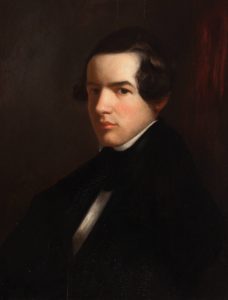
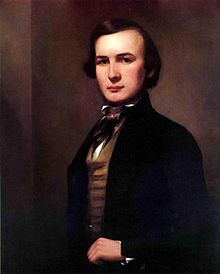
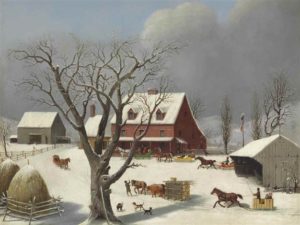
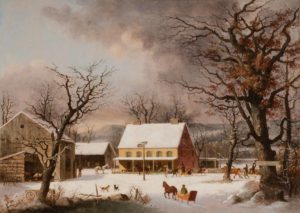
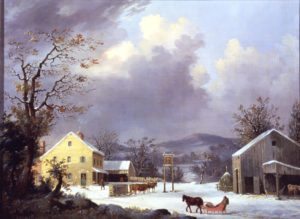
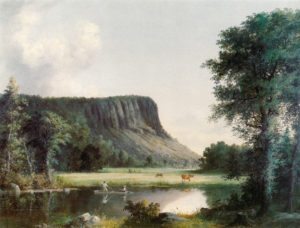
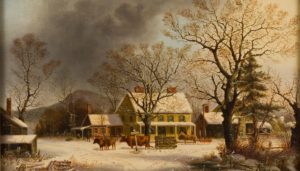
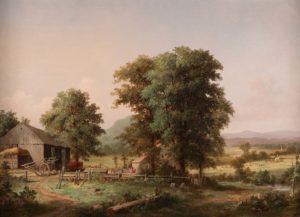
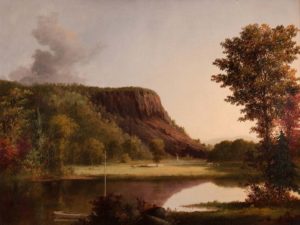
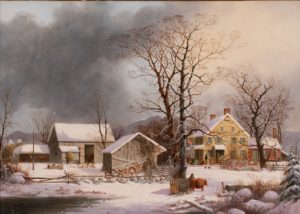
Have a question or comment regarding SEE/change? Enter your email and comment here.
"*" indicates required fields